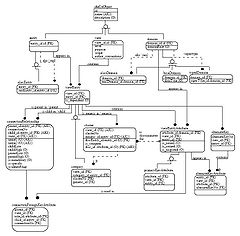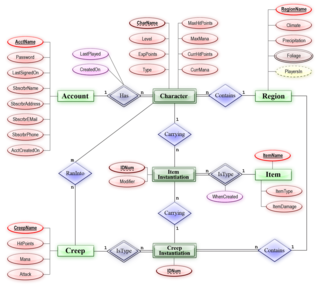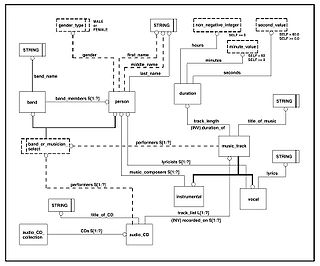
Information model
Encyclopedia

Software engineering
Software Engineering is the application of a systematic, disciplined, quantifiable approach to the development, operation, and maintenance of software, and the study of these approaches; that is, the application of engineering to software...
is a representation of concepts, relationships, constraints, rules, and operations
Operation (mathematics)
The general operation as explained on this page should not be confused with the more specific operators on vector spaces. For a notion in elementary mathematics, see arithmetic operation....
to specify data semantics
Semantic data model
A semantic data model in software engineering has various meanings:# It is a conceptual data model in which semantic information is included. This means that the model describes the meaning of its instances...
for a chosen domain of discourse. It can provide sharable, stable, and organized structure of information requirements for the domain context.
Overview
The term information model in general is used for models of individual things, such as facilities, buildings, process plants, etc. In those cases the concept is specialised to facility information modelFacility information model
A facility information model is an information model of an individual facility that is integrated with data and documents about the facility. The facility can be any large facility that is designed, fabricated, constructed and installed, operated, maintained and modified; for example, a complete...
, building information model
Building Information Modeling
Building information modeling is the process of generating and managing building data during its life cycle.BIM involves representing a design as objects – vague and undefined, generic or product-specific, solid shapes or void-space oriented , that carry their geometry, relations and attributes...
, plant information model, etc. Such an information model is an integration of a model of the facility with the data and documents about the facility.
Within the field of software engineering and data modeling
Data modeling
Data modeling in software engineering is the process of creating a data model for an information system by applying formal data modeling techniques.- Overview :...
an information model is an abstract, formal representation of entity types that includes their properties, relationships and the operations that can be performed on them. The entity types in the model may be kinds of real-world objects, such as devices in a network, or they may themselves be abstract, such as for the entities used in a billing system. Typically, they are used to model a constrained domain that can be described by a closed set of entity types, properties, relationships and operations.
An information model provides formalism to the description of a problem domain without constraining how that description is mapped to an actual implementation in software. There may be many mappings of the information model. Such mappings are called data model
Data model
A data model in software engineering is an abstract model, that documents and organizes the business data for communication between team members and is used as a plan for developing applications, specifically how data is stored and accessed....
s, irrespective of whether they are object model
Object model
In computing, object model has two related but distinct meanings:# The properties of objects in general in a specific computer programming language, technology, notation or methodology that uses them. For example, the Java objects model, the COM object model, or the object model of OMT...
s (e.g. using UML
Unified Modeling Language
Unified Modeling Language is a standardized general-purpose modeling language in the field of object-oriented software engineering. The standard is managed, and was created, by the Object Management Group...
), entity relationship model
Entity-relationship model
In software engineering, an entity-relationship model is an abstract and conceptual representation of data. Entity-relationship modeling is a database modeling method, used to produce a type of conceptual schema or semantic data model of a system, often a relational database, and its requirements...
s or XML schema
XML schema
An XML schema is a description of a type of XML document, typically expressed in terms of constraints on the structure and content of documents of that type, above and beyond the basic syntactical constraints imposed by XML itself...
s.
History


IDEF1X
IDEF1X is a data modeling language for the developing of semantic data models. IDEF1X is used to produce a graphical information model which represents the structure and semantics of information within an environment or system.IDEF1X permits the construction of semantic data models which may serve...
) , the EXPRESS Language and the Unified Modeling Language
Unified Modeling Language
Unified Modeling Language is a standardized general-purpose modeling language in the field of object-oriented software engineering. The standard is managed, and was created, by the Object Management Group...
(UML). In the 1980s there were several approaches to extend Chen’s Entity Relationship Model. Also important in this decade is REMORA by Colette Rolland
Colette Rolland
Colette Rolland is a French computer scientist and Professor of Computer Science in the department of Mathematics and Informatics at the University of Paris 1 Pantheon-Sorbonne, and a leading researcher in the area of information and knowledge systems, known for her work in meta-modeling.-...
.
The ICAM
ICAM
ICAM is short for "I couldn't agree more" - also see list of internet slangIt may also refer to:* Integrated Computer-Aided Manufacturing* Intercellular adhesion molecule* Institute for Complex Adaptive Matter...
Definition (IDEF) Language was developed from the U.S. Air Force ICAM Program during the 1976 to 1982 timeframe. The objective of the ICAM Program , according to Lee (1999), was to increase manufacturing productivity through the systematic application of computer technology. IDEF includes three different modeling methods: IDEF0
IDEF0
IDEF0 is a function modeling methodology for describing manufacturing functions, which offers a functional modeling language for the analysis, development, reengineering, and integration of information systems; business processes; or software engineering analysis.IDEF0 is part of the IDEF family...
, IDEF1, and IDEF2 for producing a functional model, an information model, and a dynamic model respectively. IDEF1X
IDEF1X
IDEF1X is a data modeling language for the developing of semantic data models. IDEF1X is used to produce a graphical information model which represents the structure and semantics of information within an environment or system.IDEF1X permits the construction of semantic data models which may serve...
is an extended version of IDEF1. The language is in the public domain. It is a graphical representation and is designed using the ER approach and the relational theory. It is used to represent the “real world” in terms of entities, attributes, and relationships between entities. Normalization is enforced by KEY Structures and KEY Migration. The language identifies property groupings (Aggregation) to form complete entity definitions.
EXPRESS was created as ISO 10303-11 for formally specifying information requirements of product data model. It is part of a suite of standards informally known as the STandard for the Exchange of Product model data (STEP). It was first introduced in the early 1990s. The language, according to Lee (1999), is a textual representation. In addition, a graphical subset of EXPRESS called EXPRESS-G is available. EXPRESS is based on programming languages and the O-O paradigm. A number of languages have contributed to EXPRESS. In particular, Ada, Algol, C, C++, Euler, Modula-2, Pascal, PL/1, and SQL. EXPRESS consists of language elements that allow an unambiguous object definition and specification of constraints on the objects defined. It uses SCHEMA declaration to provide partitioning and it supports specification of data properties, constraints, and operations.
UML is a modeling language for specifying, visualizing, constructing, and documenting the artifacts, rather than processes, of software systems. It was conceived originally by Grady Booch
Grady Booch
Grady Booch is an American software engineer. Booch is best known for developing the Unified Modeling Language with Ivar Jacobson and James Rumbaugh. Grady is recognized internationally for his innovative work in software architecture, software engineering, and collaborative development environments...
, James Rumbaugh
James Rumbaugh
James E. Rumbaugh is an American computer scientist and object methodologist who is best known for his work in creating the Object Modeling Technique and the Unified Modeling Language .- Biography :...
, and Ivar Jacobson
Ivar Jacobson
Ivar Hjalmar Jacobson is a Swedish computer scientist, known as major contributor to UML, Objectory, RUP and aspect-oriented software development.- Biography :...
. UML was approved by the Object Management Group
Object Management Group
Object Management Group is a consortium, originally aimed at setting standards for distributed object-oriented systems, and is now focused on modeling and model-based standards.- Overview :...
(OMG) as a standard in 1997. The language, according to Lee (1999), is non-proprietary and is available to the public. It is a graphical representation. The language is based on the objected-oriented paradigm. UML contains notations and rules and is designed to represent data requirements in terms of O-O diagrams. UML organizes a model in a number of views that present different aspects of a system. The contents of a view are described in diagrams that are graphs with model elements. A diagram contains model elements that represent common O-O concepts such as classes, objects, messages, and relationships among these concepts.
IDEF1X, EXPRESS, and UML all can be used to create a conceptual model and, according to Lee (1999), each has its own characteristics. Although some may lead to a natural usage (e.g., implementation), one is not necessarily better than another. In practice, it may require more than one language to develop all information models when an application is complex. In fact, the modeling practice is often more important than the language chosen.
Information models can also be expressed Gellish
Gellish
Gellish is a controlled natural language, also called a formal language, in which information and knowledge can be expressed in such a way that it is computer-interpretable, as well as system-independent. Gellish is a structured subset of natural language that is suitable for information modelling...
. Gellish, with its natural language variants Gellish English
Gellish English
Gellish English is a variant of Gellish and is a formal language, which means that it is structured and formalised subset of natural English that is computer interpretable. Its definition includes an English dictionary of concepts that is arranged in a taxonomy and that is extended into an ontology...
, Gellish Nederlands, etc. is a modeling language that is defined in the Gellish smart Dictionary, that has the form of a Taxonomy
Taxonomy
Taxonomy is the science of identifying and naming species, and arranging them into a classification. The field of taxonomy, sometimes referred to as "biological taxonomy", revolves around the description and use of taxonomic units, known as taxa...
/Ontology
Ontology
Ontology is the philosophical study of the nature of being, existence or reality as such, as well as the basic categories of being and their relations...
. A Gellish Database is not only suitable to store information models, but also knowledge models, requirements models and dictionaries, taxonomies and ontologies. An information model in Gellish uses Gellish expressions. For example, a geographic information model might consist of a number of Gellish English expressions, such as:
- the Eiffel tower
- Paris
Such Gellish expressions use names of concepts (such as 'city') and relation types (such as
Standard sets of information models
The Distributed Management Task ForceDistributed Management Task Force
Distributed Management Task Force is an industry organization that develops, maintains and promotes standards for systems management in enterprise IT environments. These standards allow for building systems management infrastructure components in a platform-independent and technology-neutral way...
(DMTF) provides a standard set of information models for various enterprise domains under the general title of the Common Information Model
Common Information Model (computing)
The Common Information Model is an open standard that defines how managed elements in an IT environment are represented as a common set of objects and relationships between them...
(CIM). Specific information models are derived from CIM for particular management domains.
The TeleManagement Forum (TMF) has defined an advanced model for the Telecommunication domain (the Shared Information/Data model, or SID) as another. This includes views from the business, service and resource domains within the Telecommunication industry. The TMF has established a set of principles that an OSS integration should adopt, along with a set of models that provide standardized approaches.
The models interact with the information model (the Shared Information/Data Model, or SID), via a process model (the enhanced Telecom Operation Map
ETOM
The eTOM , published by the TM Forum, is a guidebook that defines the most widely used and accepted standard for business processes in the telecommunications industry...
, or eTOM) and a life cycle model.
Further reading
- Richard VeryardRichard VeryardRichard Veryard is a British computer scientist, author and business consultant, known for his work on Service Oriented Architecture and the Service-Based Business.-Biography:...
(1992). Information modelling : practical guidance. New York : Prentice Hall.
External links
- RFC 3198 - Terminology for Policy-Based Management
- DMTF Homepage
- TMF Homepage

